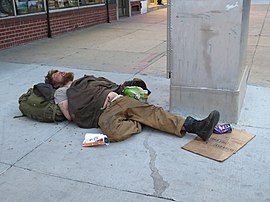
A | B | C | D | E | F | G | H | CH | I | J | K | L | M | N | O | P | Q | R | S | T | U | V | W | X | Y | Z | 0 | 1 | 2 | 3 | 4 | 5 | 6 | 7 | 8 | 9




In the United States, the number of homeless people on a given night in January 2023 was more than 650,000 according to the Department of Housing and Urban Development.[3] Homelessness has increased in recent years, in large part due to an increasingly severe housing shortage and rising home prices in the United States.[4][5]
Historically, homelessness emerged as a national issue in the 1870s.[6] Early homeless people lived in emerging urban cities, such as New York City. Into the 20th century, the Great Depression of the 1930s caused a substantial rise homelessness. In 1990, the U.S. Census Bureau estimated the homeless population of the country to be 228,621 (or 0.09% of the 248,709,873 enumerated in the 1990 U.S. census) which homelessness advocates criticized as an undercount.[7][8][9] In the 21st century, the Great Recession of the late 2000s and the resulting economic stagnation and downturn have been major driving factors and contributors to rising homelessness rates.
The main contributor to homelessness is a lack of housing supply and rising home values.[4][10][11] Interpersonal and individual factors, such as mental illness and addiction, also play a role in explaining homelessness.[10][11] However, mental illness and addiction play a weaker role than structural socio-economic factors, as West Coast cities such as Seattle, Portland, San Francisco, and Los Angeles have homelessness rates five times that of areas with much lower housing costs like Arkansas, West Virginia, and Detroit, even though the latter locations have high burdens of opioid addiction and poverty.[11][12]
Health complications are significant concern for homeless people, as lack of residence inhibits hygiene and access to healthy food,[13][14] and exposes individuals to both cold and heat stress. This contributes to increased mortality rates.[15]
Most homeless people lived in California, New York, Florida, and Washington in 2022, according to the annual Homeless Assessment Report.[16] Increases in homelessness broke records in 2022 and then again the following year.[17][18][19] In 2023, record levels of homelessness have been declared in Los Angeles and New York City, and other cities around the country have reported increased levels of homelessness, with the main drivers being a shortage of affordable housing and the increased cost of living.[5][19]
Historical background
Pre-colonial and colonial periods
Following the Peasants' Revolt in England, constables were authorized under 1383 English Poor Laws statute to collar vagabonds and force them to show support; if they could not, the penalty was gaol.[20]
Vagabonds could be sentenced to the stocks for three days and nights; in 1530, whipping was added. The presumption was that vagabonds were unlicensed beggars.[20] In 1547, a bill was passed that subjected vagrants to some of the more extreme provisions of the criminal law, namely two years' servitude and branding with a "V" as the penalty for the first offense and death for the second.
Large numbers of vagabonds were among the convicts transported to the American colonies in the 18th century.[21]
Urbanization

Homelessness emerged as a national issue in the 1870s. There are no national figures documenting homeless people's demography at this time.[6] Jacob Riis wrote about, documented, and photographed the poor and destitute, although not specifically homeless people, in New York City tenements in the late 19th century. His book, How the Other Half Lives, published in 1890, raised public awareness of living conditions in the slums, causing some changes in building codes and some social conditions.
Zdroj:https://en.wikipedia.org?pojem=Homelessness_in_the_United_States
Text je dostupný za podmienok Creative Commons Attribution/Share-Alike License 3.0 Unported; prípadne za ďalších podmienok. Podrobnejšie informácie nájdete na stránke Podmienky použitia.
Antropológia
Aplikované vedy
Bibliometria
Dejiny vedy
Encyklopédie
Filozofia vedy
Forenzné vedy
Humanitné vedy
Knižničná veda
Kryogenika
Kryptológia
Kulturológia
Literárna veda
Medzidisciplinárne oblasti
Metódy kvantitatívnej analýzy
Metavedy
Metodika
Text je dostupný za podmienok Creative
Commons Attribution/Share-Alike License 3.0 Unported; prípadne za ďalších
podmienok.
Podrobnejšie informácie nájdete na stránke Podmienky
použitia.
www.astronomia.sk | www.biologia.sk | www.botanika.sk | www.dejiny.sk | www.economy.sk | www.elektrotechnika.sk | www.estetika.sk | www.farmakologia.sk | www.filozofia.sk | Fyzika | www.futurologia.sk | www.genetika.sk | www.chemia.sk | www.lingvistika.sk | www.politologia.sk | www.psychologia.sk | www.sexuologia.sk | www.sociologia.sk | www.veda.sk I www.zoologia.sk
